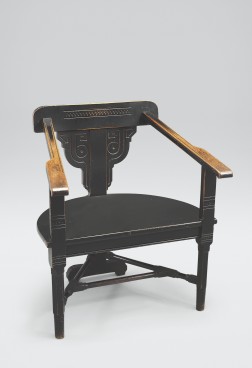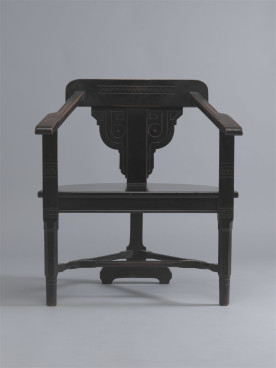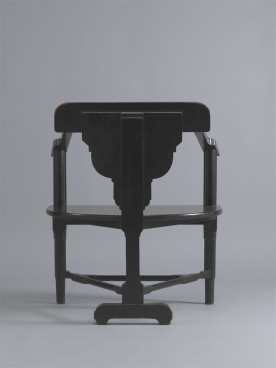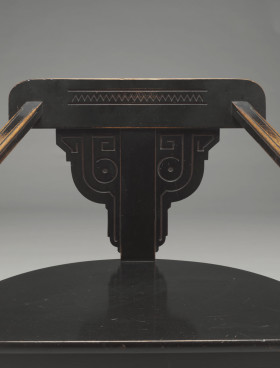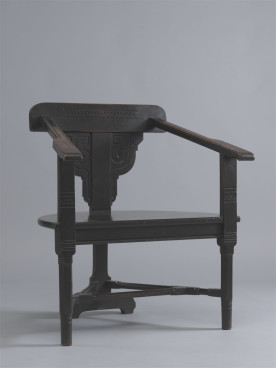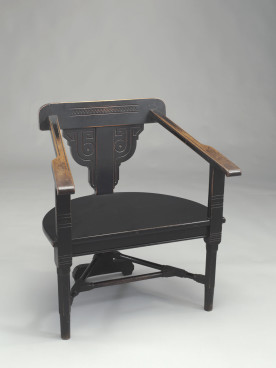Armchair, c.1880
Ebonised walnut with incised decoration
The design is attributed to Christopher Dresser. This chair comes from a suite of furniture probably designed for Dresser’s solicitor, Hiram Abiff Owston (1830–1905), at Bushloe House in Wigston Magna, Leicestershire, and probably made by William Booty, London. It is sometimes called the ‘Elephant’ chair.
Adam Bowett Catalogue 14/08/2012
Description
An ebonised armchair, c.1880. The chair has a semicircular seat from which the back rises in modified T shape, the crest rail support by broad, shaped brackets with shallow incised decoration; the arms slant down from either end of the back to square supports embellished with incised decoration; the forelegs are hexagonal in section with turned feet. The single back post has a trestle foot and is connected to the front legs by turned stretchers.
Dimensions
H: 29 ½ ” (75cm) Seat height: 14 ¾ ” (37cm) W: 25 ½ “ (65cm) D: 17 “ (43cm)
Designer/Maker
Designed by Dr. Christopher Dresser for the Art Furnishers’ Alliance
Materials
Walnut and possibly other woods
Dating Criteria
The design is thought to date from about 1880 (see references). It is sometimes called the ‘elephant chair’.
Construction
The principle structural elements are; the T-shaped back post descending all the way to the floor, the front posts, and the seat which connects both elements. It is difficult to determine the exact construction because the whole chair is japanned with a black finish. However, the back has a central strut extending from the foot to half way up the crest rail. It is probably lapped onto the crest rail which forms the crossbar of the T, and the shaping to either side is probably glued and dowelled to the central strut and also lapped over the top rail. At the bottom, the strut is probably tenoned into the trestle foot. The arms are either dowelled or tenoned to the back and presumably rest on a stub tenon rising from the front posts. The front posts change in section from top to bottom but are of one piece, and the front edge of the seat is fitted around them. At the back the edge of the seat is similarly fitted or notched around the back post. Underneath the seat there is a front rail tenoned into the front posts, and two diagonal braces extending from the front posts to the back, all three elements are screwed up to the seat. The stretchers are presumably tenoned front and back and the medial stretcher tenoned into the side stretchers.
Condition
The ebonised finish is original and worn at exposed points, particularly the top surface of the arms, the corners and edges. The chair is structurally sound and there are no breaks. All show surfaces are finished to a high gloss; the under surfaces have a matte finish.
Additional remarks
This chair was probably part of a suite of which three other chairs and a table are known. Probably made by the Art Furnisher’s Alliance, but further information is lacking.
References
Jeremy Cooper, Victorian and Edwardian Furniture and Interiors, Hong Kong (1978), pl. 295 (illus.).
Harry Lyons, Christopher Dresser: The People’s Designer 1834-1904, Woodbridge 2005, pl. 258 (illus.).
Michael Whiteway, Christopher Dresser 1834-1904, Milan (2001), pl. 191 (illus.).
Widar Halen, Christopher Dresser, Oxford (1990), fig. 57 (illus.).
Provenance
Paul Reeves

